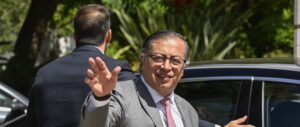Bishop Juan Carlos Barreto
Bishop, Quibdó
Father Sterlin Palacios
Vicar, Pastoral Social, Quibdó
Leyner Palacios
Victims’ Leader, Bojayá, Chocó
Danilo Rueda
Co-Director, Inter-Church Commission for Justice and Peace (CIJP)
Father Adriel Ruiz
Buenaventura, Colombia
And moderator
Gimena Sánchez
Senior Associate for the Andes, WOLA
After half a century of conflict, Colombia appears to be nearing peace. Historic peace talks have been ongoing since October 2012 between the Colombian government and the country’s largest guerrilla group, the Revolutionary Armed Forces of Colombia (Fuerzas Armadas Revolucionarias de Colombia, FARC). Exploratory talks are underway with the National Liberation Army (Ejército de Liberación Nacional, ELN).
Meanwhile, combat operations between the armed groups continue to produce new displacements, human rights abuses and humanitarian emergencies impacting Afro-Colombian and indigenous civilians throughout the Chocó Department. According to the most recent report from the Consultancy for Human Rights and Displacement (CODHES), Chocó had the highest per capita rate of displacement in the country, contributing to Colombia’s position as the country with the second largest internally displaced population in the world. The Human Rights Ombudsman has declared that the crisis in Chocó requires immediate judicial and administrative actions, or the country could be found in violation of international requirements to protect vulnerable populations, a claim supported by the United Nations.
Buenaventura, the most important port on Colombia’s Pacific coast for its strategic location and connection to the interior of the country, has grown infamous for the prevalence of “chop-up” houses and territorial divisions by paramilitary successor groups. Human Rights Watch reported that between January 2010 and December 2013, 150 people have been disappeared—more than in any municipality in the country; 13,468 persons have been displaced in 2013 alone; and impunity for these crimes remains the norm as few perpetrators are held accountable. Despite international attention, violence and threats against communities and activists continue in Buenaventura.
The Catholic Church’s Pastoral Social—or Caritas—program based in Quibdó, Choco, has worked to accompany these communities at risk throughout Chocó. By organizing communities and calling attention to abuses, the Pastoral Social program has offered a peaceful resistance to armed actors and pressed for state policies that protect ethnic communities. At the forefront of these efforts are Bishop Juan Carlos Barreto andFather Sterlin Londoño.
In Buenaventura, the local community has created a humanitarian zone in response to the vicious violence in the port city. Such a space guarantees that communities can safely exist in the ancestral lands without fear of retribution simply for crossing the wrong street. Danilo Rueda of the Inter-Church Commission for Justice and Peace (Comisión Intereclesial de Justicia y Paz, CIJP) has accompanied the community in this endeavor and will present on the security obstacles faced by this community and their proposals for peace.
Leyner Palacios, a survivor of the 2002 Bojayá massacre perpetrated by the FARC, traveled to Havana as part of a delegation of victims to discuss their proposals for peace with the parties at the negotiating table. The massacre took the lives of 79 people, many of whom were inside a church at the time.
All the panelists will provide recommendations for how US policy makers, donors, and the international community can best address the challenges in these two parts of the country as Colombia transitions from conflict to peace.

